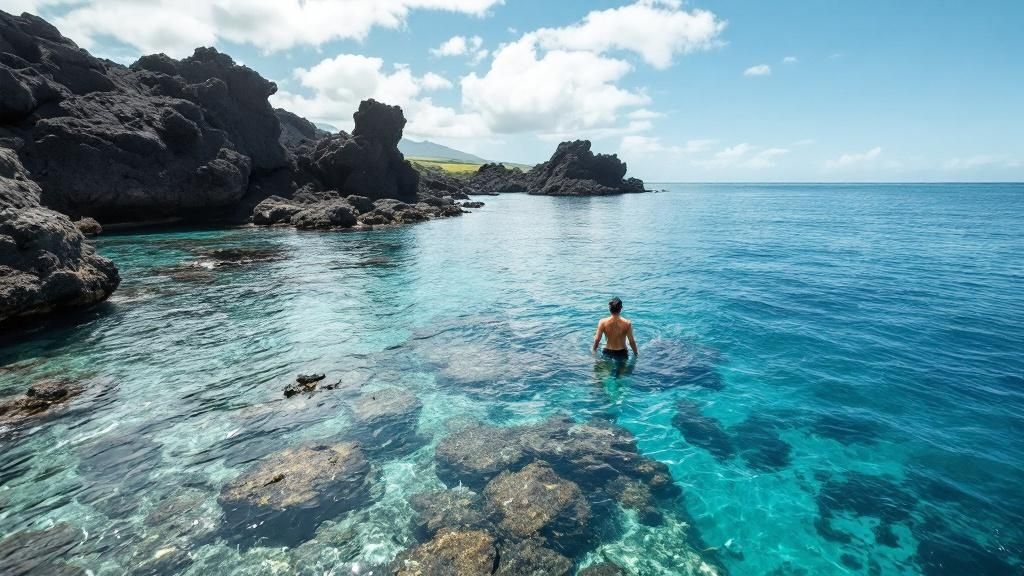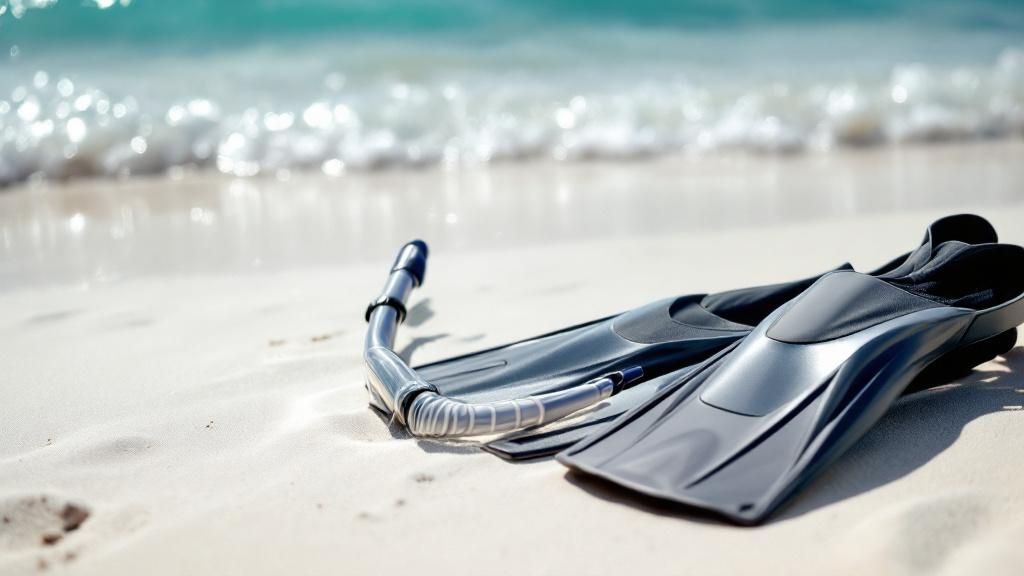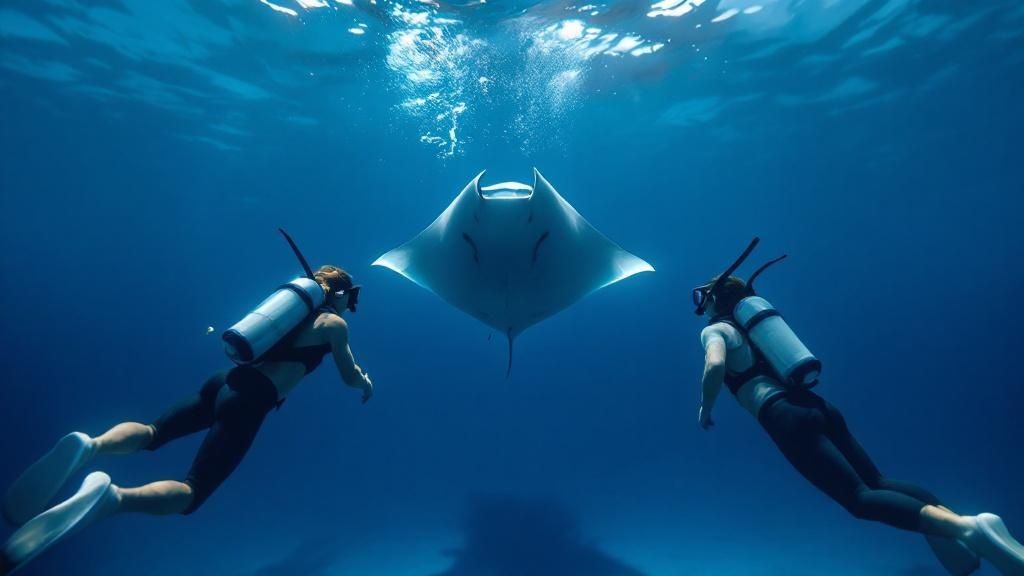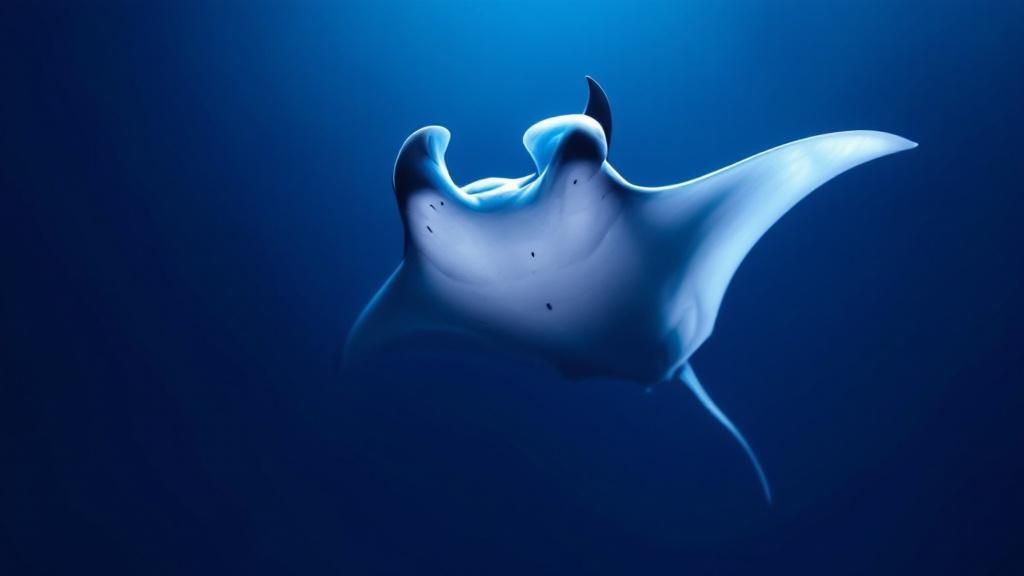Big Island Manta Ray Snorkel Big Island: Ultimate Guide
- Byron
- Jul 4
- 14 min read
If there's one wildlife encounter on the Big Island that feels truly out of this world, it's the manta ray night snorkel. This isn't just another boat trip; it's a front-row seat to an incredible underwater ballet, and it happens with surprising reliability. Along the Kona coast, tours have an incredible success rate of over 80-90%. I've been on this tour myself, and I can tell you firsthand, it's an experience that stays with you forever.
Your Guide to the Kona Manta Ray Snorkel
Imagine this: you're floating in the warm, dark Pacific waters as the sun dips below the horizon. Below you, powerful lights illuminate the ocean, creating a beacon for plankton. Then, they appear. Giant, gentle manta rays, some with wingspans stretching over 12 feet, glide effortlessly out of the darkness. They swoop, somersault, and barrel roll just inches from your face, feeding on the plankton attracted to the light. It's a surreal combination of thrilling and profoundly peaceful.
The Kona coast is uniquely perfect for this. The calm, protected bays have become a reliable feeding ground for a large, resident population of manta rays. Over the years, tour operators have dialed in a system that works like a charm. They set up floating "light boards," which act like a bug zapper for plankton. This creates a concentrated, all-you-can-eat buffet that the mantas simply can't resist. It’s this ingenious, non-invasive method that makes the encounters so consistent.
The Two Hotspots: Where Will You Go?
Most tours head to one of two main locations along the Kona coast. Both are fantastic, but they have subtle differences that might make one a better fit for your group.
Keahou Bay (Manta Village): This is the classic spot, located just south of Kailua-Kona. It's known for being incredibly consistent and is often called "Manta Village" for a reason. A huge plus here is the short boat ride, which is a lifesaver if you or someone in your party is prone to seasickness.
North of Kona Airport (Manta Heaven): This site, near Garden Eel Cove, is sometimes referred to as "Manta Heaven." While the boat ride from Honokohau Harbor is a bit longer, the payoff can be huge. It's not uncommon for this spot to attract larger groups of mantas, sometimes a dozen or more at once.
To help you decide, here's a quick breakdown of the two locations:
Quick Look At Big Island Manta Snorkel Locations
Feature | Keahou Bay (Manta Village) | North of Kona Airport (Manta Heaven) |
|---|---|---|
Location | South of Kailua-Kona | North of Kona Airport |
Boat Ride | Shorter (great for seasickness) | Longer |
Consistency | Highly reliable, the "original" site | Very reliable, but can vary |
Manta Numbers | Often good, consistent numbers | Can attract very large groups |
Best For | Families, those short on time, or anyone worried about getting seasick. | Adventurous swimmers, photographers looking for a massive group shot. |
Ultimately, you can't go wrong with either spot. The tour operators are experts at finding the mantas, and both locations offer a spectacular show.
The unbelievable consistency of these sightings isn't just marketing hype; it's backed by real data. A long-term study tracking manta encounters from 2009 to 2014 found a success rate between 80% and 90% for snorkel and dive tours. That’s a statistic very few wildlife experiences anywhere in the world can claim.
What A Typical Tour Feels Like
Your adventure usually kicks off with a sunset boat ride. The crew will give you a safety briefing and share some genuinely fascinating facts about the manta rays you're about to meet—these are intelligent, gentle creatures, and learning about them makes the experience even richer.
Once you arrive at the spot, you'll slide into the water. You don't need to be a super-swimmer for this. You'll hold onto a custom-built floatation board that has the bright lights pointing down into the deep. From there, your only job is to float, watch, and be amazed as the show unfolds right below you.
For a complete play-by-play, check out our **ultimate tour guide for the manta ray snorkel on the Big Island**. This is your best resource for planning a safe, ethical, and truly unforgettable night with these gentle giants.
How to Choose the Right Manta Ray Tour

With a ton of tour operators lining the Kona coast, picking the right one for your manta ray snorkel Big Island adventure can feel like a pretty big deal. It's more than just booking a boat; the company you choose and the vessel they use will absolutely shape your entire night. Nailing this decision is the first step toward a magical, safe, and truly respectful encounter with these gentle giants.
One of the first things you'll need to decide is what kind of boat you want to be on. The two main options are a big, steady catamaran or a smaller, more zippy vessel like a Zodiac. There's no "better" choice here—they just offer completely different vibes.
Large Boats vs. Small Charters
Big catamarans are fantastic if you're traveling with family, are a little nervous about your first time, or tend to get seasick. Their sheer size means a much smoother ride and plenty of room to walk around. Plus, they usually have amenities like an onboard restroom, which is a real bonus. The only trade-off is the crowd; you’ll be sharing the water with a larger group, which can feel a bit less personal.
On the flip side, smaller boats deliver a more adventurous, intimate experience. With just a handful of other people, you get a lot more facetime with the guides. It feels less like a tour and more like a private expedition, getting you in and out of the water fast. The catch? You'll feel the waves more, and you'll be giving up some of those creature comforts.
Key Questions to Ask Before You Book
Before you hand over your credit card, a little digging can make all the difference. Asking the right questions helps you find a tour that matches what you're looking for and aligns with your values.
Here are the non-negotiables to ask any potential operator:
What's your guide-to-guest ratio? You want a low number here, something like 1 guide for every 8-10 people. This means better supervision and a safer, more personal trip.
Are you "Manta Ray Green" certified or do you follow similar sustainable practices? This certification is a huge green flag, showing the company is serious about protecting the mantas and their home.
What’s your manta sighting success rate? Nothing in nature is guaranteed, but the best operators are open about their track record, which is often above 90%.
What happens if we don't see any mantas? Most great companies have a "manta guarantee." This usually means you can come back another night for free. Pro tip: book your tour early in your vacation just in case you need to use that second chance!
A reputable operator will always prioritize the well-being of the manta rays. Their pre-snorkel briefing should be thorough, covering not just safety but also clear rules about not touching the animals and how to behave respectfully in their presence.
Must-Have Features of a Quality Tour
Beyond the boat and your checklist of questions, keep an eye out for other signs of a top-notch operation. A great educational briefing is an absolute must. You're not just there to see the mantas; learning about their biology and behavior makes the whole experience so much richer.
Also, confirm that they provide all the gear you’ll need—and that it’s in good shape. Wetsuits, masks, and snorkels should be well-maintained. The lighting setup is also key. The best outfits use powerful, custom light boards that attract plankton super effectively without bothering the mantas.
By focusing on these details, you’re not just booking a tour; you’re setting yourself up for an ethical, unforgettable, and truly mind-blowing adventure. For an even deeper dive into what to expect, check out our ultimate guide with more tips for the manta ray snorkel on the Big Island.
Getting Ready for Your Manta Ray Adventure

So you've booked your tour—congratulations! The excitement is probably starting to kick in. A little bit of smart prep work can truly elevate your experience from just good to absolutely unforgettable. When you know what to pack and what to expect, you can stop worrying about the little things and just immerse yourself in the magic of your manta ray snorkel on the Big Island.
First things first: what to wear. Your tour company will provide a wetsuit, but what do you wear underneath? A simple, comfortable swimsuit is all you need. The easiest way to do it is to wear your suit under your regular clothes when you head to the harbor. You'll be glad you did when it's time to gear up on the boat.
After the snorkel, you will be so happy you brought a warm towel and a set of dry clothes. A windbreaker or a cozy hoodie is a fantastic idea, too. Even in Hawaii, the boat ride back to shore can get pretty chilly once you're out of the water.
Pre-Snorkel Checklist
Here’s a quick list of must-haves and other things to think about before you leave for the boat.
Reef-Safe Sunscreen: If you're on a sunset tour, make sure to apply this a few hours before you get on the boat. The chemicals in regular sunscreen are toxic to coral reefs, and giving it time to soak in keeps it from washing off into the ocean.
Motion Sickness Remedies: Are you even slightly prone to seasickness? Take medication or use a patch before you start to feel queasy. It works best as a preventative. If you're worried, look for tours on larger catamaran-style boats, which offer a much smoother ride.
Towel & Dry Clothes: Don't forget these! You'll want them for the ride back.
Underwater Camera: A GoPro is perfect for this, but make sure you know how to use its low-light settings. And this is a big one: never use a flash. The bright light can disorient and scare the mantas.
A common question I hear is whether to eat before the tour. I always recommend a light snack a couple of hours beforehand to keep your energy levels up. Just avoid anything heavy or greasy, which is never a good mix with a boat trip.
What If I'm a Little Nervous?
It’s totally normal to feel a bit of anxiety, especially if you aren’t the strongest swimmer or have never snorkeled at night. I've been there!
Here’s the good news: you don't have to be Michael Phelps to do this. The tour operators provide amazing flotation devices. On most tours, you simply hold onto a large, custom-built light board that floats on the surface. You just hang on and watch the show below you.
Your guides are lifeguard-certified and are in the water with you the entire time. Don't be shy about voicing any concerns. They are pros whose main job is to make sure you feel safe and have an incredible time. A little preparation goes a long way in calming those nerves so you can focus on the amazing encounter ahead.
What to Expect During Your Snorkel

This boat ride isn't just about getting from point A to point B; it’s your orientation. The guides run through a detailed safety briefing, covering everything from how your gear works to the strict rules for interacting with the mantas. Listen up, because these guidelines are crucial for keeping both you and the rays safe.
Entering the Underwater Theater
Just as twilight fades, you’ll reach the snorkel spot. This is where the crew works their magic, switching on a set of powerful, submerged lights. This is the secret sauce behind Kona's world-famous encounters. These bright lights draw in massive clouds of tiny plankton, creating a glowing, all-you-can-eat buffet right at the surface. It’s like an underwater campfire, and the manta rays are the guests of honor.
Slipping into the dark, surprisingly warm water is a feeling you won't forget. The crew will hand you a large, custom-built flotation board to hold onto. These boards are genius—they have lights built right into the bottom, which concentrates the plankton even more and brings the mantas directly to you. Your only job is to float, keep your body flat, and watch the show. You don't need to be a great swimmer, just relax and hold on.
It's a surreal moment when that first manta ray appears. One second you're just staring into the bright, plankton-filled water, and the next, a massive, shadowy figure glides silently out of the dark. It’s humbling, breathtaking, and honestly, a little bit mind-blowing.
The Manta Ray Ballet
What follows is nothing short of an underwater ballet. The manta rays, some with wingspans stretching over 12 feet, perform these incredible, graceful somersaults and barrel rolls as they feed. They swoop up from below, mouths wide open to filter the plankton, sometimes coming within inches of your mask. Their movements are so fluid and powerful, it's completely mesmerizing.
To make sure the experience is safe and respectful for everyone (especially the mantas), there are a few simple but non-negotiable rules:
Look, Don't Touch: This is the golden rule. Manta rays have a protective mucus layer on their skin that acts as their immune system. If you touch them, you can damage this coating and leave them vulnerable to infection.
Stay Horizontal: Just float. Keep your legs and fins flat on the surface. If you kick down, you could accidentally hit a manta and disrupt its feeding pattern.
Let Them Come to You: Never, ever chase a manta ray. The best encounters happen when you stay still and let them control the interaction. They'll come to you.
Sticking to these rules ensures the mantas continue to see this area as a safe and reliable dinner spot. After about 45 minutes in the water, you’ll climb back on the boat, buzzing with awe and a story you’ll be sharing for the rest of your life.
Protecting Kona's Unique Manta Rays

There’s nothing quite like a **manta ray snorkel on the Big Island**. It’s an otherworldly experience, but it’s also a deeply personal encounter with a very special—and fragile—marine population. Because of this, picking the right tour operator is the single most important decision you’ll make.
Your choice isn’t just about having a good time; it directly affects the health and future of these incredible animals. This is where responsible tourism becomes absolutely essential. The best operators adhere to community-vetted standards, many of which were pioneered by programs like the 'Manta Ray Green' certification. While the official program has changed over the years, its core principles are still the benchmark for a sustainable and respectful tour.
Why Choosing the Right Operator Matters
A certified or recognized sustainable operator isn't just giving you a tour; they're acting as guardians of the manta rays. They voluntarily follow strict guidelines designed to keep the mantas safe, comfortable, and free from stress. These aren’t just suggestions—they are proven conservation practices.
Here’s what you can expect from a top-tier, responsible crew:
No Touching, Ever: This is the golden rule. Their guides will make it crystal clear that touching a manta ray strips away its protective slime coat, which is like our skin. Losing it makes them vulnerable to serious infections.
Giving Them Space: You'll be instructed to stay flat on the surface as a snorkeler or on the seabed as a diver. This keeps the water column clear, allowing the mantas to swim and feed without feeling crowded or trapped.
Education is Key: The best tours include a fantastic educational briefing. You won’t just learn the rules; you’ll understand why they exist, which creates a much deeper appreciation for the animals you’re about to meet.
When you book with an operator who lives by these standards, you're doing more than just buying a ticket. You’re casting a vote with your wallet for the long-term protection of this amazing ecosystem. You become a true partner in conservation.
A One-of-a-Kind Population
The manta rays you’ll see off the Kona coast are truly unique. It’s not just a feeling—it’s a scientific fact. Genetic studies have confirmed this is an isolated population, completely distinct from the mantas you might see around Maui or other Hawaiian islands.
The local breeding population is astonishingly small, with only about 104 adult breeding mantas identified.
This genetic isolation makes Kona’s manta ray community both a remarkable biological phenomenon and an urgent conservation priority. With such limited gene flow between islands, protecting this small, unique population is entirely up to the local community and responsible visitors.
This fragility highlights just how important every single interaction is. When you slip into that water, you’re entering the home of an animal community that exists nowhere else on the planet. Making the right choice helps ensure this magical encounter can continue for many years to come.
Answering Your Manta Ray Snorkel Questions
Even after you've picked your tour, it's totally normal to have some last-minute questions buzzing around your head. This isn't your average snorkeling trip, after all! It’s a truly unique encounter, and a little curiosity is a good thing.
We've been there, so we’ve put together answers to the questions we hear most often from first-timers. Getting these cleared up beforehand means you can just relax and soak in every magical moment of your manta ray snorkel Big Island experience.
Is It Really Safe to Swim with Manta Rays?
This is easily the number one question we get, and the answer is a huge, enthusiastic yes! Manta rays are the definition of gentle giants. It's easy to be intimidated by their massive size, but they are completely harmless to people.
They are filter feeders, which is a scientific way of saying their diet is made up of microscopic plankton. Manta rays do not have a stinger, a barb, or any teeth. Unlike their stingray cousins, they have no way to hurt you. Your only job is to look, not touch, as human hands can damage the protective mucus coating on their skin.
What Happens If No Mantas Show Up?
It's a valid concern—this is wild nature, not an aquarium. While the tour operators in Kona have an incredible track record (often over a 90% success rate), there’s never a 100% guarantee.
This is where reputable companies really shine. Nearly all of them offer a "manta guarantee." If your tour is one of the very rare unlucky ones where the mantas decide not to show, most companies will let you come back another night for free. This is exactly why we always tell people to book their manta trip for one of their first nights on the island. It gives you a built-in safety net to reschedule if you need to.
Always double-check the company's specific "no-show" policy before you hand over your credit card. A clear, customer-friendly guarantee is a great sign you're dealing with a top-notch operator who is confident in their crew and their location.
Is There a Best Time of Year to See Them?
Here’s the great news: Kona's manta rays are here all year long! They are a resident population, which means they don't migrate. You can book a trip in July or December and have an excellent chance of a fantastic encounter.
That said, the time of year does affect the overall experience.
Summer (April-October): This is when you'll typically find the calmest, glassiest ocean conditions. The weather is warm and the boat ride is usually smoother, making it a very comfortable experience.
Winter (November-March): The mantas are still feeding every night, but the open ocean can be a different story. Winter months can bring bigger swells and more wind, which sometimes leads to tour cancellations for safety.
No matter the season, the mantas are ready for their plankton feast.
What's the Difference Between Snorkeling and Diving?
The biggest difference is simply your point of view. Both are incredible ways to see the mantas, but they offer two very different perspectives on the same underwater show.
Feature | Manta Ray Snorkel | Manta Ray Dive |
|---|---|---|
Position | Floating on the surface, holding onto a light board. | Kneeling on the sandy ocean floor, about 30-40 feet deep. |
View | Looking down as the mantas swoop up from the darkness toward your light. | Looking up as the mantas perform graceful barrel rolls just inches above your head. |
Requirement | Anyone who can swim. | You must be a certified scuba diver. |
Best For | Nearly everyone, including families, kids, and first-timers. | Certified divers who want a truly immersive, bottom-up perspective. |
For most people, snorkeling is the ideal choice. You're positioned right where the action is—at the surface, where the lights concentrate the plankton. This gives you a front-row, face-to-face seat for the entire underwater ballet.
Ready for an adventure you’ll never forget? At Manta Ray Night Snorkel Hawaii, our expert guides and small group sizes ensure a safe, personal, and breathtaking encounter with Kona’s gentle giants. Book your tour today!
Comments